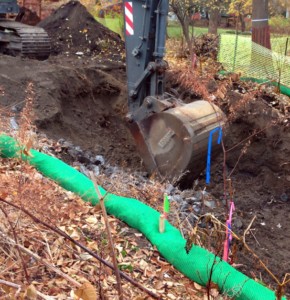2017 NPDES Construction General Permit (CGP) – Effective February 16, 2017
 “Stormwater discharges from construction activities can significantly impact water quality. As stormwater flows over a construction site, it can pick up pollutants like sediment, debris, and chemicals and transport them to nearby storm sewer systems or directly into rivers, lakes, or coastal waters. The NPDES stormwater program requires a permit for discharges from construction activities that disturb one or more acres, and discharges from smaller sites that are part of a larger common plan of development or sale. Construction stormwater permits include effluent limits for erosion and sediment control, pollution prevention, and site stabilization.” (EPA NPDES)
“Stormwater discharges from construction activities can significantly impact water quality. As stormwater flows over a construction site, it can pick up pollutants like sediment, debris, and chemicals and transport them to nearby storm sewer systems or directly into rivers, lakes, or coastal waters. The NPDES stormwater program requires a permit for discharges from construction activities that disturb one or more acres, and discharges from smaller sites that are part of a larger common plan of development or sale. Construction stormwater permits include effluent limits for erosion and sediment control, pollution prevention, and site stabilization.” (EPA NPDES)
The 2017 NPDES Construction General Permit (CGP) took effect on Thursday, February 16, 2017 and will last for five years. The newly effective 2017 NPDES CGP coverage is available for operators of eligible construction activities in Idaho, Massachusetts, New Hampshire, New Mexico, and the District of Columbia. This permit supersedes the 2012 CGP.
If a project site is currently covered under the 2012 CGP and it is anticipated that it will continue past May 17, 2017, then the site Operators (Owner and Contractor) have until May 17, 2017 to submit a new Notice of Intent (NOI) under the 2017 CGP. This includes updating their Stormwater Pollution Prevention Plan (SWPPP) to meet the new or amended requirements.
Please note that the eNOI process has been replaced with the NPDES eReporting Tool (NeT). For existing CDX website users, the login won’t change but preparers and certifiers will need to add the NeT program to their CDX account. A few relevant changes are summarized below.
PCBs & Building Demolition
For sites that discharge to a PCB-impaired water, if you are demolishing a building with at least 10,000 SF OR a building that was renovated before 1/1/1980, then: 1) the building location and associated pollutants must be documented in the SWPPP, and 2) controls must be implement to minimize the discharge of PCBs to Waters of the US.
On all sites, external building washdown waters with hazardous substances (e.g. PCBs) are explicitly prohibited from discharging to Waters of the US.
Stockpiles and Land Clearing Piles
In addition to the existing temporary stabilization requirements, inactive piles must meet the same stabilization deadlines as the rest of the project area.
Stabilization Deadlines
If the site does not discharge to a sensitive water (TMDL or high quality water), and the site disturbances can be phased to be less than five acres open at any one time, then the site is eligible for longer stabilization timeframes.
For more information on the newly effective NPDES CGP, please contact Jennifer E. Gilbert of Tighe & Bond at 413.572.3212 or JEGilbert@tigheBond.com


